The Beginning
Salem, 1692. Abigail, age eleven, and Betty, age nine, were telling their fortunes by the light of the fire. The tradition was English superstition: crack an egg into a glass of water, then wait for it to settle into shape. The silhouette of the egg could predict the profession of your future husband. An anchor, a sailor – a pitchfork, a farmer. So on and so forth, folktale foretold.
Puritan faith forbade the practice, so the two girls were cautious, though curious. What sorceries could foresee their spouse...? The egg broke, settled, took shape... The configuration of a coffin emerged in the glass... Both Betty and Abigail were sized with fits. Stunned and "struck dumb," they choked and convulsed, uncontrollably thrashed their limbs. What unnatural affliction had found them?
Then Ann and Elizabeth began to exhibit similarly strange behavior. They crept under chairs and stools, gestured frantically, uttered intelligibly... The girls made strange, animalistic noises – barking like dogs, twisting and twitching. They flapped their arms as if they could take to the air.
Salem's Girls, rumors whispered, were bewitched.
Suspicions of Witchcraft
Rumors of witchcraft snatched Salem Village. Salemites accused their neighbors of possessing animals or children. Some declared to have discovered poppets or witches' familiars. Ann Putnam Jr. and Mercy Lewis plead to see "witches flying through the winter mist." Tituba insisted that she could consort with the Devil. Specters, or spirits, were spotted midair. "Witches" appeared in the visions of the afflicted, demanding they sign the Devil's Book. What else was done by dark art? If the aged went blind, was it not by bewitchment? Illness, infirmity – all thought to be brought forth by black magic.
The "Afflicted" Girls
The Parris Household applied ointment to the "afflicted" girls, yet their remedies could not restore them. Was there a natural cure for an unnatural disease? Betty and Abigail continued to "flinch, crouch, and gabble," immune to potions or prayers. Reverend Parris consulted the Reverend Cotton Mather's Memorable Providences, Relating to Witchcrafts and Possession, whose account of two bewitched children matched Salem's own. Parris began to believe that the Devil dominated the young girls; even Dr. Williams Griggs soon confirmed that Betty and Abigail were "under an evil hand."
Mercy Lewis, Mary Warren, and Mary Walcott soon alleged their afflictions, their bodies distorting and warping, arms outstretched and unbound.
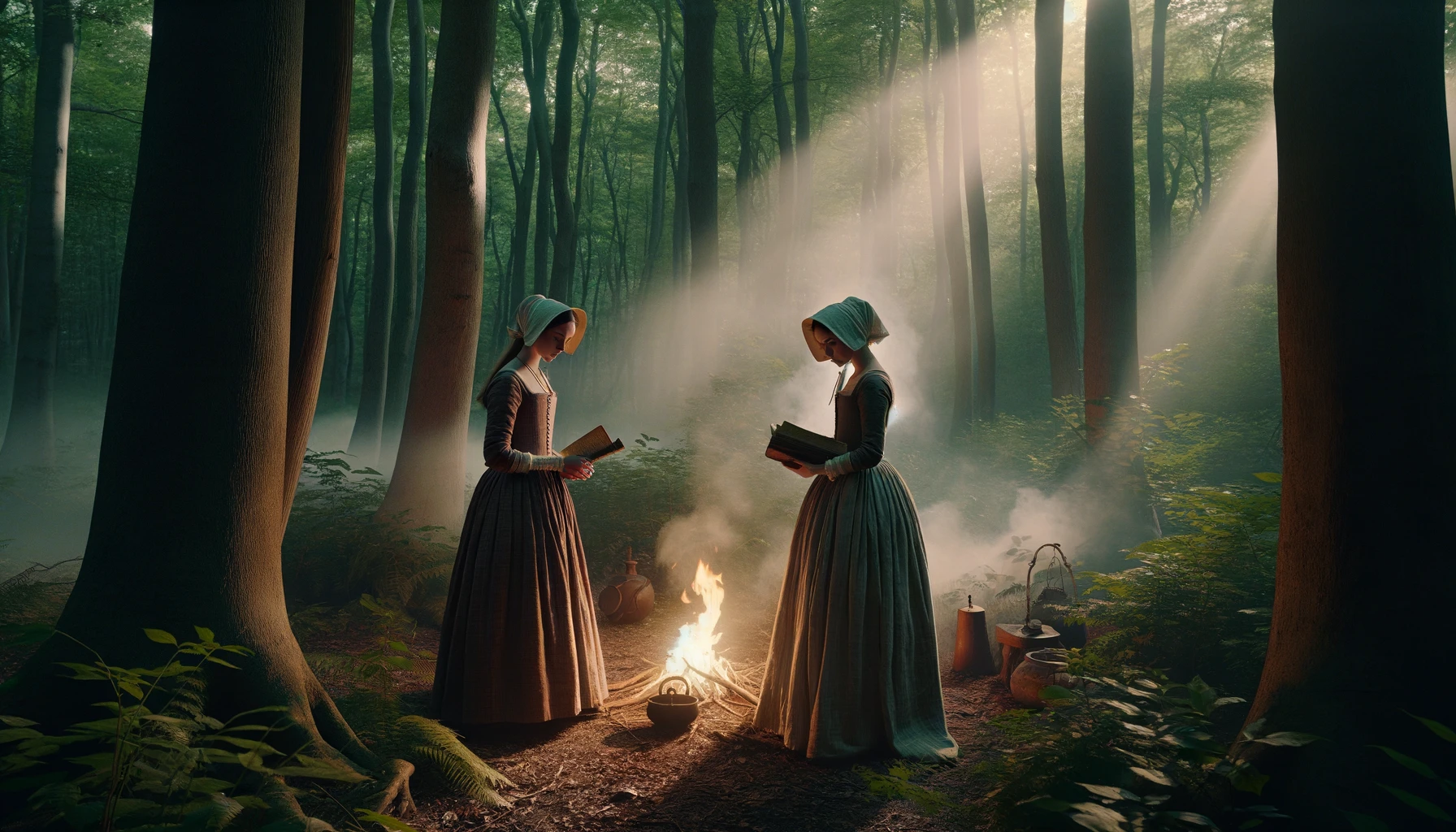 It was said that young women were practicing witchcraft in Salem
It was said that young women were practicing witchcraft in Salem
Salem's Accusers Accused
There were ten "afflicted girls," in total, yet some, such as the twenty-five-year-old Sarah Churchill or the eighteen-year-old Mary Warren, were both accusers and confessors. Confessing to witchcraft allowed you a pardon – though only if you pointed your finger at another "witch."
Accusations
Read more about the Accusers and Accused of the Salem Witch Trials.
Tituba, a Caribbean slave, was the first accused. Betty and Abigail claimed that Tituba had been a witch, yet Tituba reinforced their accusations, alleging that she and the girls rode on sticks. Two rats, Tituba said, had told her to serve them. Tituba's was an unusual testimony, though her false confession did, in fact, spare her execution. Tituba, who pleaded guilty, was pardoned.
Betrayals Abound
Then came the accusations of Sarah Good and Sarah Osburne. Sarah Good maintained her innocence, though blamed Osburne for black magic. Good's husband William cautioned Goody Ingersoll about a wart on his wife's right shoulder. Witches' teat, suspected William. Giles Corey, too, incriminated his wife – only to find the gallows himself.
Unexpected Accusations
Martha Cory was the fourth accused, an unexpected accusation as Cory was a respected community member, then Rebecca Nurse. At seventy-one years-of-age, her arraignment shocked an already stunned Salem Village. John Proctor was later accused, though only after the imprisonment of his wife, Elizabeth. Proctor had doubted the validity of the "afflicted," threatening to "thrash the devil" out of them. There was a price to pay for the disregard of Salem's daughters, yet. Proctor was imprisoned.
Over two hundred would come to be accused, though only nineteen were hanged until death.
Salem's Scapegoats
The "sins" of the accused were unorthodox rather than unnatural: children born out of wedlock, the death of a spouse, remarriage, social discord. Those first prosecuted were easy targets for witchcraft convictions. For example, Bridget Bishop was a tenacious, thrice-married matron. Her "sins," Judge Nathaniel Saltonstall argued, were "little more than wearing scarlet, countenancing shovel board, and getting herself talked about... all offenses, but hardly capital offenses." Yet Bishop was charged with possessing pigs and poppets – or working spells on Salemites.
Sarah Osburne once had an affair with an indentured servant. Sarah Good was a beggar. The socially marginalized were set as scapegoats – indicted, incriminated, incarcerated.
 It was said that young women were practicing witchcraft in Salem
It was said that young women were practicing witchcraft in Salem
Arrests
Tituba, Sarah Good, and Sarah Osburne were the first issued warrants for their arrest. Taken to Nathaniel Ingersoll's Tavern, they were interrogated by Judge John Hathorne and Judge Jonathan Corwin. Although Hannah Ingersoll found no "witches mark" upon them, Tituba "confessed" to witchcraft while naming the other two as witches; she then detailed her consorts with Satan.
Sarah Osburne and Sarah Good both maintained their innocence, yet Good blamed Tituba and Osburne for black magic. Soon arrests were made for others who had been unjustly accused, such as Martha Corey, Rebecca Nurse, Elizabeth Proctor, and Sarah Cloyce.
Salem Jail
Although Sarah Good, one of the earliest arrested, was first held at Ipswich, she was later moved to Salem Jail. Yet with poor ventilation and poorer hygiene, Salem Jail was an unbearable basement – drab and damp, rank with rats and sewage. Those wanted for witchcraft had as much hope here as they did the "hanging tree." Indeed, four of those arrested – Lydia Dustin, Ann Foster, Sarah Osborne, and Roger Toothaker – died while imprisoned.
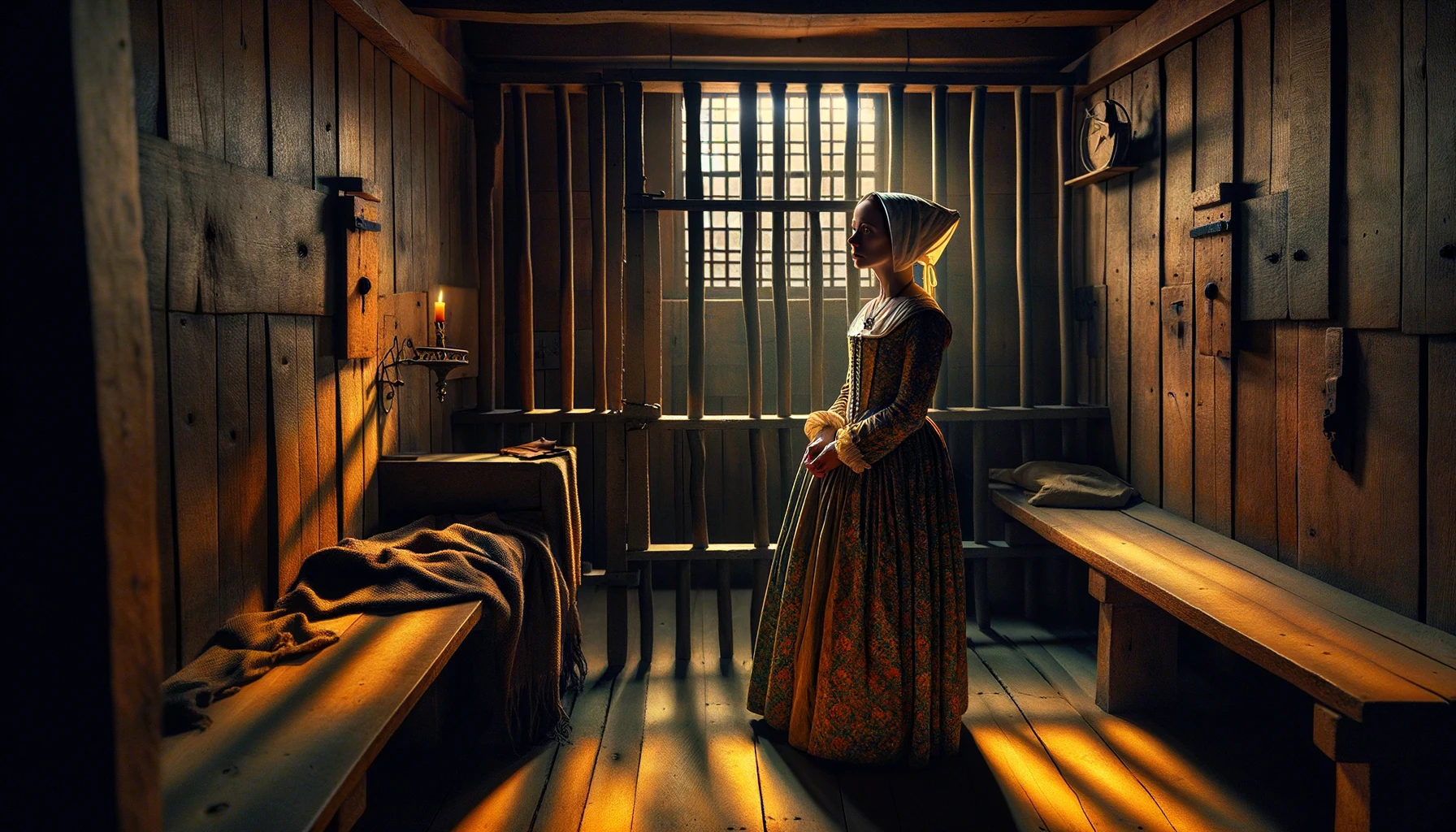 Bridget Bishop was jailed after she was suspected of witchcraft
Bridget Bishop was jailed after she was suspected of witchcraft
The Youngest Accused
Dorcas, or Dorothy Good, daughter of Sarah Good, was the youngest brought forth for interrogation. She was four years of age. During her interrogation, Dorothy "confessed" to witchcraft, claimed to possess a witches' familiar, and bit her interrogators as if she were a small animal. Although Dorothy was never indicted or tried, she was imprisoned for nine months at Salem Jail. Her sister, Mercy Good, was, too, in Salem Jail. Born shortly after Sarah Good's arrest, Mercy died soon after birth.
Salem's Skeptics
Not all of Salem suspected witchcraft. Twenty Salemites signed a petition on behalf of both John and Elizabeth Proctor. Their petition maintained the innocence of the Proctors, rebutting their convictions of witchcraft. There were even those outside of Salem who objected to Salem's examinations, such as the thirty-two dissenters of Ipswich whose petition denounced the use of spectral evidence. And, although Cotton Mather advised that the Court of Oyer and Terminer make their prosecution "speedy and vigorous," he likewise urged that they not rely on spectral evidence alone.
Trials and Examinations
The accused were, at first, brought to Ingersoll's Ordinary. Yet the tavern was too small for the spectacle. If the interrogations were to be public, they would need space. The trials were then relocated to the Salem Meetinghouse, where Tituba, Sarah Osburne, and Sarah Good were the first examined. Rebecca Nurse, Dorothy Good, Martha and Giles Corey, Bridget Bishop, and Mary Easty were examined soon after.
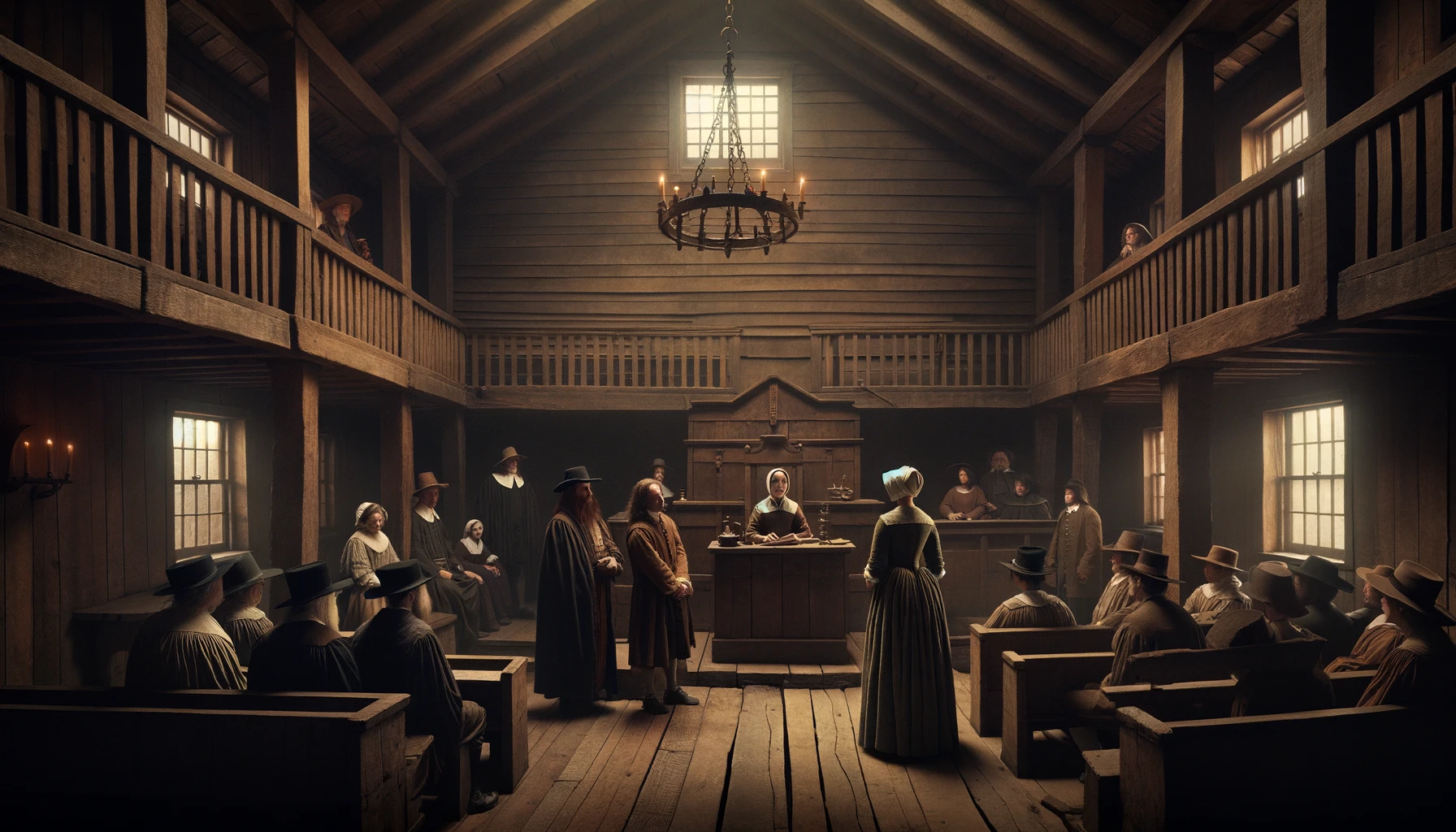 A rendition of the courtroom scene during the Witch Trials
A rendition of the courtroom scene during the Witch Trials
The Witch Court
The Court of Oyer and Terminer was specifically established for Salem's Witch Trials. John Hathorne was the chief magistrate, though the Court included magistrates Stoughton, Richards, Gidny, Winthrop, Sewall, Sargeant, and Saltonstall, who was later replaced by Corwin. Hathorne had previous experience hanging "witches," yet the "witches" were Quakers, not conjurers. Corwin's father, Captain George Corwin, likewise had a history for "witch" hunts: when George discovered two Quakers aboard his ship, he had them arrested for witchcraft. Both Hathorne and Corwin were, to Salem Village, impressive appointments to the Court of Oyer and Terminer.
Yet it was Stoughton who oversaw the "special" court of Oyer and Terminer as chief judge and prosecutor. When the jury found Rebecca Nurse not guilty, it was Stoughton who sent them back to "reconsider." Stoughton likewise admitted spectral evidence – the eyewitness accounts of the afflicted gathered through dreams, hallucinations, or visions.
Terrors, Tortures, and Trials
Confessions were forced, accusations coerced. Martha Carrier's sons were tortured until they testified against her. Giles Cory was not hanged but pressed. Spectral evidence was considered, witches' teats tracked. The examinations required the suspects stripped and searched – an invasive procedure that violated Salem's most vulnerable. Women, children, the elderly. If there was a mole, a wart, or a bit of loose skin, then the bearer practiced black magic. Any "unnatural" bodily growth or feature indicated witchcraft. To Salem Village, these "abnormalities," or "witches' teats" suckled a witch's servant – like a familiar, or daemon.
Verdicts and Sentencing
By June of 1692, Massachusetts law that prohibited death by hanging was resurrected and reinstated. Executions were allowed for witchcraft. There were, in all, four execution dates. On June 10, Bridget Bishop was the first to be hanged. Then, on July 16, Sarah Good, Elizabeth Howe, Susannah Martin, Rebecca Nurse, and Sarah Wildes.
By August 19 – Martha Carrier, John Willard, Reverend George Burroughs, George Jacobs, Sr. and John Proctor. By September 22 – Mary Eastey, Martha Corey, Ann Pudeator, Samuel Wardwell, Mary Parker, Alice Parker, Wilmot Redd, and Margaret Scott.
The Hanging Tree
Nineteen were hanged at Proctor's Ledge. Their bodies were unceremoniously castoff in its crevice. Bridget Bishop, Sarah Good, Elizabeth Howe, Susannah Martin, Rebecca Nurse, and Sarah Wilde were the first "witches" hanged at Proctor's Ledge, but they wouldn't be the last.
Although Gallows Hill was once thought to be Salem's site of execution, the Gallows Hill Project confirmed that it was, instead, Proctor's Ledge. Situated on the outskirts of Salem, Proctor's Ledge made the witchcraft executions an unrestricted spectacle.
While we cannot undo the crimes against them, we can remember the injustices enacted upon them. This remembrance, with hope, may prevent us from repeating the 1692 "Witch Hysteria."
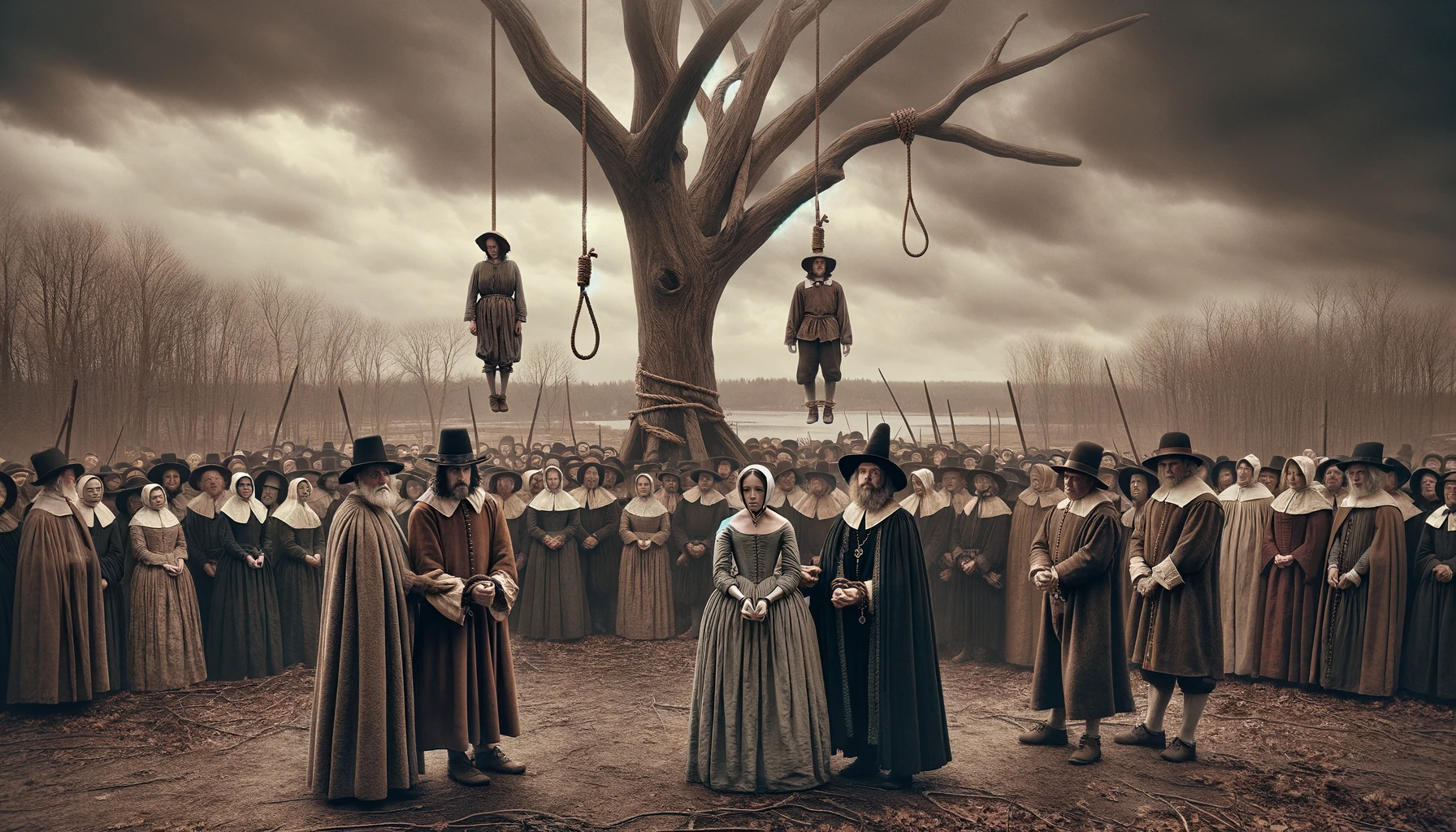 The people found guilty of Witchcraft were hanged on Proctor's Ledge in Salem
The people found guilty of Witchcraft were hanged on Proctor's Ledge in Salem
What influenced the Salem Witch Trials?
"The oldest and strongest emotion of mankind is fear, and the oldest and strongest kind of fear is fear of the unknown." - H. P. Lovecraft
There is no single explanation for why the Salem Witch Trials happened. It seems like faith was to blame for the madness but there were other factors involved. These, combined with the lack of scientific knowledge at the time, created somewhat of a perfect storm in Salem. Fear, jealousy, and ignorance gave way to some of the most horrific events of the New World.
Religion
In the late 16th century, Puritanism arose within The Church of England. Puritans were a religious reform group with strict moral beliefs and conservative views. They rejected activities like drinking and gambling, among many other things, in the pursuit of a righteous life.
After facing religious persecution in England, some Puritans migrated to Massachusetts and established colonies ruled by their churches. This move allowed them to begin anew, building a society that was impervious to the Devil's temptations. However, women and children were considered to be weak members of society, and it was believed that this weakness would eventually allow the Devil to infiltrate their innocent colony.
Salem's "Social Outliers"
It is no surprise that some of the first people accused of witchcraft in Salem were considered to be social outcasts. These were people that had stopped attending church or women known for having sexual relations before marriage. Such 'scandals' threatened the immaculate communities that the Puritans tried so hard to achieve.
Puritans were convinced that God - or the Devil - would manifest through mankind. Thus, when someone exhibited deviant behavior, this meant they had strayed away from the divine. Sadly, this absurd belief system resulted in the imprisonment and execution of many that were only guilty of challenging the patriarchy.
Witch Trials in Europe
Witch trials took place throughout all of Europe, starting from the early 14th century until the late 17th century. Curiously, the time of the witch trials coincided with a period of extremely cold weather in Europe and North America known as the Little Ice Age.
The Little Ice Age is considered to be the catalyst for the European witch trials since the intense temperatures were causing crops to fail and diseases to spread.
In the past, no one had an explanation for why things happened, and magic was often used to interpret the mysteries of the world. This was a time centered in duality: God vs. the Devil, Good vs. Evil, etc., and magic was no exception. Just like white magic was believed to heal and bring about good fortune, black magic was believed to curse, kill and destroy. Naturally, as crops died and diseases festered, churches started hunting witches to eradicate the dark magic that was plaguing their people.
The residents of Salem were no strangers to witch hunts, as Puritans had seen how both Catholics and Protestants persecuted people in Europe for practicing dark magic. Thus, when the youths of Salem became afflicted by an unexplainable disease, they thought that the Devil must now be upon them.
A recently proposed theory published in The Economic Journal observes the witch trials from a modern, marketing perspective. Upon its rise, the Protestant Church was posing a major threat to the established Catholic Church in Europe. This gave way to a power struggle as each religion wanted to prove they were the only way to salvation. This article argues that the witch trials were a way for each religion to demonstrate how effective they were at defeating the Devil. The Puritans of Salem, after separating themselves from the Protestant Church, likely wanted to prove they too could rid themselves of the evils of hell.
 A Portrait of Matthew Hopkins, Witch Hunter
A Portrait of Matthew Hopkins, Witch Hunter
Matthew Hopkins aka Witchfinder General
The fear of the occult had haunted England for centuries and Matthew Hopkins knew how to capitalize on it. When it comes to vile human beings, Hopkins takes the cake. Appointed Witchfinder General in 1645 - yes, this was his official title - he set out to kill every single suspected witch that crossed his path. He would travel from town to town with his men, examining women for signs of witchcraft and burning them. His services came at a price and he was being paid handsomely for doing God's work.
Evidence of Witchcraft
To determine if a woman was a master of the dark arts, the Witchfinder would conduct a series of tests. One of these was known as the "Swimming Test", where he would tie a person to a chair, bind their hands and feet tightly, and throw them into a river. If they sank, they were good; if they floated, they were witches.
At the time, water was thought to be holy and would, therefore, reject witches, causing them to float. Ropes were tied around the waist of the person to pull them out of the water if they passed the test. Unfortunately, he was often unable to pull them out and would simply let them drown.
Hopkins would also prick and cut suspected witches to see if they bled. It was believed that the Devil would mark the body of his worshippers with sores, moles, birthmarks, or extra nipples, and since these areas were cursed, they would not bleed or feel pain. However, the heinous Witchfinder would often use retractable blades that would not pierce the skin of the accused. This allowed him to continue to capitalize on his work since he would collect payment for each convicted witch.
The unfortunate actions of the Witchfinder fueled the witch craze in England, as the existence of witches kept being 'proven' by these horrifying tests. The English colonists of the New World were familiar with the Witchfinder and possibly thought it was their religious responsibility to carry on this gruesome endeavor in the Americas.
Malleus Maleficarum
Yet before there was the Witchfinder, there was the Malleus Maleficarum.
The Malleus Maleficarum, or the Hammer of Witches, was a fifteenth-century treatise on witchcraft. Written by Heinrich Kramer and published in Speyer, Germany, the Malleus Maleficarum detailed how to examine and exterminate alleged "witches." The Malleus Maleficarum's recommended method? Torture.
If the Devil is real, then witches, the Malleus Maleficarum maintained, must be real.
Jacob Sprenger's name was added to the publication in 1519. By the seventeenth-century, the Malleus Maleficarum was considered an authoritative text on demonology and witchcraft persecution. The Malleus Maleficarum likewise initiated new witch hunts, leading to the unjust executions of women, "heretics," and social outcasts.
 The Malleus Maleficarum was popular reading for those interested in tracking down "Witches"
The Malleus Maleficarum was popular reading for those interested in tracking down "Witches"
Ergot Poisoning
In the 1970s, Psychologist Linda Caporael proposed an ergot poisoning theory as an explanation for the strange disease that afflicted the young girls of Salem. Ergot is a fungus that infects cereal grains - rye in particular - and causes bizarre effects that are similar to consuming LSD.
Individuals with ergot poisoning usually have hallucinations, crawling sensations on the skin, convulsions, vomiting, muscle spasms, etc. The girls, however, were only experiencing some of these symptoms but not all of them.
Cold winters, followed by warm, damp springs are ideal for ergot propagation and The Little Ice Age provided the perfect weather conditions for an infestation. Rye was the most common grain used for bread making in Salem and the timing of when the girls' symptoms started does support this theory. However, this hypothesis has been widely dismissed and other explanations have been proposed.
Understanding the Trials
The motivation behind the Salem Witch Trials is largely disputed. Other factors that influenced the Salem Witch Trials include the tensions between Salem Village and Salem Town, Tituba's confession, as well as the political environment at the time. What we can all agree on is that these were foul and unnecessary crimes. Many lives were unjustly taken and families destroyed.
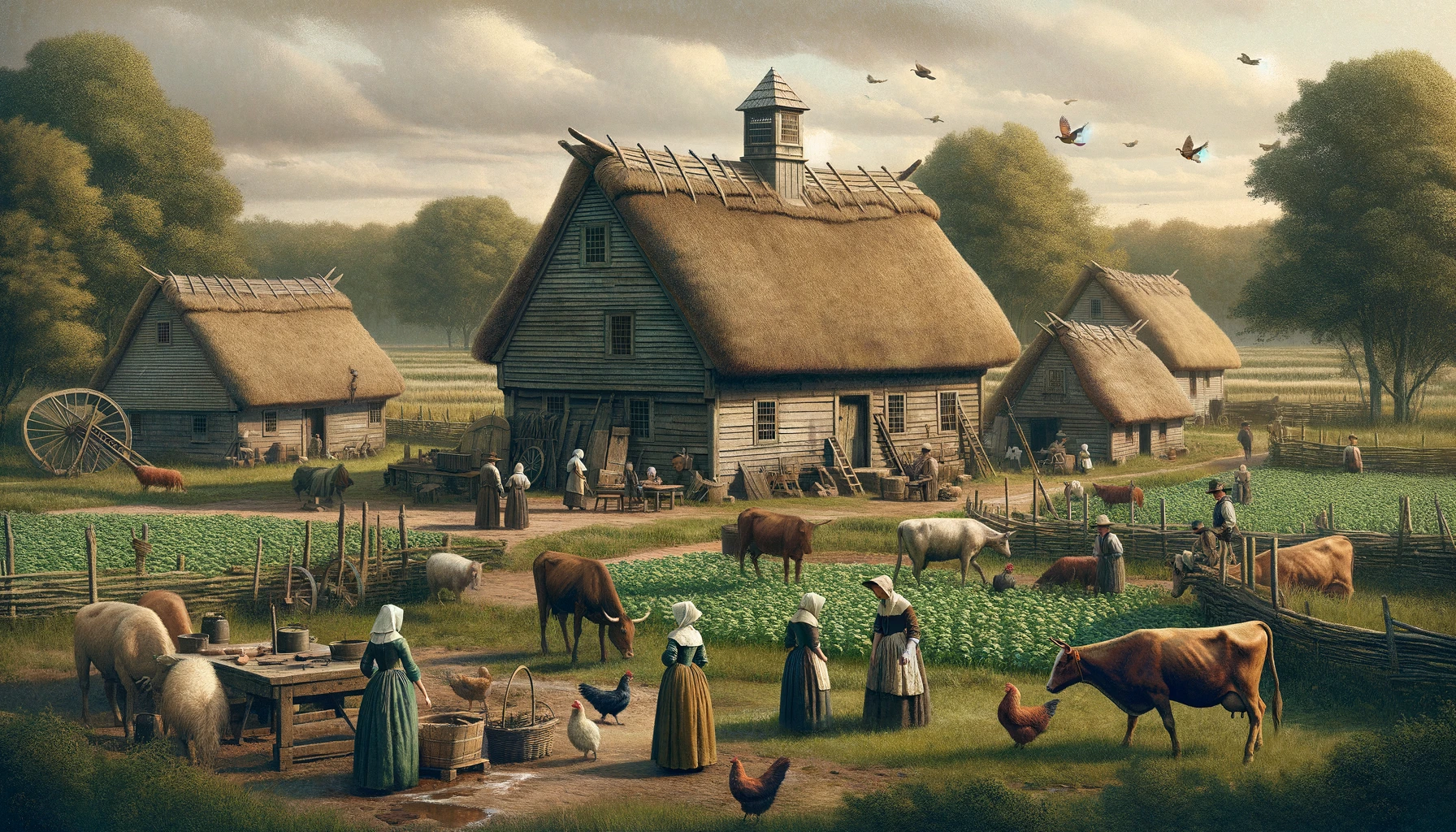 A scene of what Salem would have looked like during the times of the Salem Witch Trials
A scene of what Salem would have looked like during the times of the Salem Witch Trials
The Salem Witch Trials in Context
While Europe was in the throes of "witch hunts," Salem was being settled by the English. Yet belief in black magic was widespread in the colonies as well as the continent. Indeed, Salem had recently recovered from both a smallpox epidemic and Native American Wars, making the village susceptible to superstition. Writings on witchcraft, such as Cotton Mather's Memorable Providences, were likewise prolific. But what was seventeenth-century Salem? What happened in Salem to make way for the Witch Trials?
Cotton Mather's "Memorable Providences"
Was Cotton Mathers Memorable Providences: Relating to Witchcraft and Possession the source of Salem's hysteria? Published three years before Salem's Witch Trials, Memorable Providences detailed the accounts of "several bewitched and possessed person in New-England." Mather chiefly described the symptoms of witchcraft as seen through an Irish washerwoman, Goody Glover, though also related the accounts of two Goodwin children he oversaw. The afflictions of the Goodwin children matched those of Betty and Abigail, leading some to believe that Betty and Abigail had access to the book.
Robert Calef, a contemporary of Cotton Mather, opposed Memorable Providence, later citing Mather's publication as the groundwork for Salem's Witch Trials. Indeed, Calef wrote that "Mr Cotton Mather, was the most active and forward of any Minister in the Country in those matters, taking home one of the [Goodwin] Children, and managing such Intreagues with that Child, and after printing such an account of the whole, in his Memorable Providences, as conduced much to the kindling of those Flames, that in Sir Williams time threatened the devouring of this Country."
Mather's basis for witchcraft persecution? Exodus 22:18 – "Thou shalt not suffer a witch to live."
Early Witchcraft Laws
The Puritan Massachusetts Bay Colony, and therefore Salem, was at the time theocratic. In 1641, they had established their first legal code, The Massachusetts Body of Liberties. The text was undeniably progressive; it identified the rights of women, children, and colonial "freemen." Yet it was religiously intolerant: witchcraft, for example, was capital punishment. And, indeed, Rule 94 required that "If any man or woman be a witch, that is, hath or consulteth with a familiar spirit, they shall be put to death."
Yet The Body of Liberties, like Mather's Memorable Providences, did not define what constitutes a "witch." Puritans were thereby allowed to subjugate all religious "dissenters," depriving them of rights backed by English Common Law. In addition, the Witchcraft Act of 1604 had formerly defined witchcraft a felony, with a first offense punishable by a year's imprisonment. Only a second offense incited an execution. The Massachusetts Body of Liberties overturned the Witchcraft Act of 1604, laying the groundwork for Salem's Witch Trials.
Native American Wars
The 1675 King Philip's War, or the First Indian War, began in Rhode Island and Plymouth Colony. King Philip's War was armed combat between the New English Federation – allied with the Mohegan and Mohawk tribes – against King Philip of the Wampanoag. Yet King Philip found coalition with the Nipmuck, Narragansett, Pocumtuck tribes, making the combat a civil as well as colonial. King's Philip War is now cited as America's deadliest battle.
King Philip's War was followed by King William's War in 1689, a struggle between the English and Iroquois against the French and Abenaki. Nine of Salem's "afflicted girls" had witnessed the bloodshed of the Native American Wars, while others had ties to the northern frontier. For example, Ann Putnam Jr's father had been a Sergeant in King Philip's War, while Mary Walcott's great uncle, George Ingersoll, had been a lieutenant. Some believe that the stress of the wars contributed to a "mass hysteria" within Salem, raising Salem's collective anxieties.
Sanitation and Smallpox
Before Salem's Witch Trials, a smallpox epidemic ravaged Salem Village. In 1692, 500 inhabitants of the area died from the disease. Cotton Mather himself lost a wife and three children to smallpox – an effect of witchcraft, perchance? Unlikely, yet Cotton Mather did consider if the spread of the disease was supernatural.
Financial Crisis
The "Little Ice Age"
As mentioned before, another theory is that the Salem Witch Trials were caused by a period of lower-than-average temperatures. Economist Emily Oster was able to pinpoint that Europe's most active witchcraft trials occurred over a 400-year period of cold weather. Again, lower-than-average temperatures caused crop failure and food shortage – "witches," who were thought to control the weather, were a simpler scapegoat than climate change. And, indeed, Salem did experience an uncharacteristically cruel winter between 1680 and 1730.
Agreeing with Oster was Salem State University's Tad Baker. Baker, who showed evidence of Salem's Reverend Samuel Parris "arguing with his parish over the wood supply," added that "the higher the misery quotient, the more likely you are to be seeing witches." How much did the economic uncertainties caused by the "Little Ice Age" affect – or incite – Salem's Witch Trials?
Aftermath
In total, over twenty innocent lives were lost to the intolerance of the Court of Oyer and Terminer. In 1697, five years later, the General Court ordered that residents fast in atonement for their participation in Salem's Witch Trials. Yet the trials weren't declared unlawful until 1702, and reparations were not attempted until 1711. Salem did, however, pass a bill to restore the names of those affected. The colony likewise granted £600 in restitution to their heirs.
It wasn't until 1957 that Massachusetts issued a formal apology for Salem's Witch Trials.
Salem's Survivors
There are those, however, who survived Salem's Witch Trials. In May 1692, Massachusetts Governor Sir William Phips released 153 prisoners incarcerated for Salem's Witch Trials. Why? Phips' wife, Lady Mary Phips, had been recently accused.
There are also those whose trials had been pardoned or continued. Abigail Faulkner's execution was delayed due to her pregnancy, yet she was pardoned before giving birth. Dorcas Hoar, condemned to hang, was given a temporary reprieve – yet the trials ended before her execution. Elizabeth Proctor was inexplicably let go. Dorothy Good, Sarah Morey, and Frances Elizabeth Alcock Hutchin were released on bond, and John Alden escaped from prison.
Salem Today
Today's Salam, nicknamed "Witch City" in 1892, operates in historic testimony to Salem's Witch Trials. Over one million travelers visit Salem annually, bringing in more than $100 million in tourism. The majority of those pilgrimage to Salem in reverence of the Salem Witch Trials, though there are others who frequent Salem for its maritime or colonial histories.
Memorializing Those Unjustly Executed
The Salem Witch Trials Memorial was dedicated on August 5, 1992, by Elie Wiesel. Elie Wiesel, a Nobel Laureate and Holocaust survivor, spoke: "If I can't stop all of the hate all over the world in all of the people, I can stop it in one place within me."
"We still have our Salems," Wiesel added.
Designed by landscape architect Martha Lyon, Proctor's Ledge was later dedicated on July 19, 2017 – the 325th anniversary of the first execution. Proctor's Ledge was confirmed the execution site for Salem's Witch Trials in January 2016, providing testimony to those who had been hanged until death. Mayor Driscoll honored the history of Proctor's Ledge in a press release for the memorial, stating that the memorial "presents an opportunity for us to come together as a community, recognize the injustice and tragedy perpetrated against those innocents in 1692, and recommit ourselves to the values of inclusivity and justice."
Remembering the Dead
Humanity's actions in the past do make us reflect on how we live today and the actions we take. It is reasonable to believe that future generations might look at us with the same disdain as we do our Puritan ancestors.
The souls of those falsely accused haunt our history as much as our imagination. Perhaps studying Salem's Witch Trials can remind us to ward off intolerance and superstition. Or perhaps they can remind us how much, or how little, we've overcome the 1692 "Witch Hysteria."
